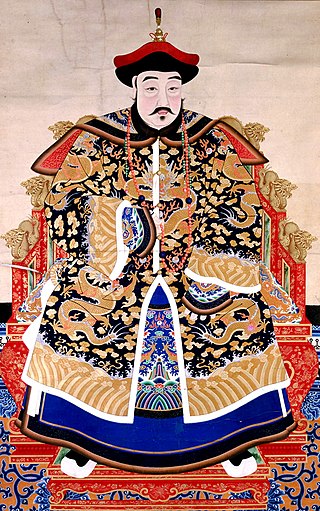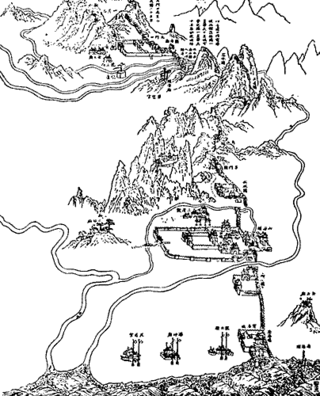Contents
| |||||
| Decades: | |||||
|---|---|---|---|---|---|
| See also: | Other events of 1645 History of China • Timeline • Years | ||||
Events from the year 1645 in China .
| |||||
| Decades: | |||||
|---|---|---|---|---|---|
| See also: | Other events of 1645 History of China • Timeline • Years | ||||
Events from the year 1645 in China .

Dorgon, was a Manchu prince and regent of the early Qing dynasty. Born in the House of Aisin-Gioro as the 14th son of Nurhaci, Dorgon started his career in military campaigns against the Ming dynasty, Mongols and Koreans during the reign of his eighth brother, Hong Taiji, who succeeded their father.

The Shunzhi Emperor, born Aisin-Gioro Fulin, was the second emperor of the Qing dynasty of China, and the first Qing emperor to rule over China proper, reigning from 1644 to 1661. A committee of Manchu princes chose him to succeed his father, Hong Taiji (1592–1643), in September 1643, when he was five years old. The princes also appointed two co-regents: Dorgon (1612–1650), the 14th son of the Qing dynasty's founder Nurhaci (1559–1626), and Jirgalang (1599–1655), one of Nurhaci's nephews, both of whom were members of the Qing imperial clan.

Li Zicheng, born Li Hongji, also known by the nickname, Dashing King, was a Chinese peasant rebel leader who overthrew the Ming dynasty in 1644 and ruled over northern China briefly as the Yongchang Emperor of the short-lived Shun dynasty before his death a year later.

Wu Sangui, courtesy name Changbai (長白) or Changbo (長伯), was a notorious Ming dynasty military officer who played a key role in the fall of the Ming dynasty and the founding of the Qing dynasty in China. In Chinese folklore, Wu Sangui is regarded as a disreputable Han Chinese traitor who played a pivotal role in several historical events, including the Battle of Shanhai Pass, Manchu invasion of China, the suppression of Southern Ming resistances and the execution of the Yongli Emperor, and eventually double-crossed both of his masters, the Ming and the Qing dynasties.

Chen Yuanyuan (1624–1681) was a Chinese Yiji who lived during the late Ming and early Qing dynasties. She was the concubine of Wu Sangui, the Ming dynasty general who surrendered Shanhai Pass to the Manchu-led Qing dynasty, and later rebelled in the Revolt of the Three Feudatories. Chen's life and relationship to Wu later became the subject of a number of popular stories and legends, many of them focusing on her supposed role in Wu's fateful decision to defect to the Qing, thereby sealing the fate of the Ming dynasty.

The Chongzhen Emperor, personal name Zhu Youjian, courtesy name Deyue (德約), was the 17th and last Emperor of the Ming dynasty. He reigned from 1627 to 1644. "Chongzhen," the era name of his reign, means "honorable and auspicious."

Dodo, formally known as Prince Yu, was a Manchu prince and military general of the early Qing dynasty.

Shi Kefa, courtesy names Xianzhi and Daolin, was a government official and calligrapher who lived in the late Ming dynasty. He was born in Xiangfu and claimed ancestry from Daxing County, Shuntian Prefecture. He was mentored by Zuo Guangdou (左光斗). He served as the Minister of War in Nanjing during the early part of his career. He is best remembered for his defence of Yangzhou from the Qing dynasty and was killed when Yangzhou fell to Qing forces in April 1645. After his death, the Southern Ming granted him the posthumous name "Zhongjing". Nearly a century later, the Qianlong Emperor of Qing granted Shi Kefa another posthumous name, "Zhongzheng" His descendants collected his works and compiled them into a book titled Lord Shi Zhongzheng's Collections (史忠正公集).
The Hongguang Emperor, personal name Zhu Yousong, childhood nickname Fuba (福八), was the first emperor of the Chinese Southern Ming dynasty. He reigned briefly in southern China from 1644 to 1645. His era name, "Hongguang", means "great light".

The Battle of Shanhai Pass, fought on May 27, 1644 at Shanhai Pass at the eastern end of the Great Wall, was a decisive battle leading to the beginning of the Qing dynasty rule in China proper. There, the Qing prince-regent Dorgon allied with former Ming general Wu Sangui to defeat rebel leader Li Zicheng of the Shun dynasty, allowing Dorgon and the Qing army to rapidly conquer Beijing.

The Shun dynasty, officially the Great Shun, also known as Li Shun, was a short-lived Chinese dynasty that existed during the Ming–Qing transition. The dynasty was founded in Xi'an on 8 February 1644, the first day of the lunar year, by Li Zicheng, the leader of a large peasant rebellion, by proclaiming himself "emperor" (皇帝) instead of the title "king" (王) before founding the dynasty.
The Southern Ming, also known in historiography as the Later Ming, officially the Great Ming, was an imperial dynasty of China and a series of rump states of the Ming dynasty that came into existence following the Jiashen Incident of 1644. Shun forces led by Li Zicheng captured Beijing and the Chongzhen Emperor committed suicide. The Ming general Wu Sangui then opened the gates of the Shanhai Pass in the eastern section of the Great Wall to the Qing banners, in hope of using them to annihilate the Shun forces. Ming loyalists fled to Nanjing, where they enthroned Zhu Yousong as the Hongguang Emperor, marking the start of the Southern Ming. The Nanjing regime lasted until 1645, when Qing forces captured Nanjing. Zhu fled before the city fell, but was captured and executed shortly thereafter. Later figures continued to hold court in various southern Chinese cities, although the Qing considered them to be pretenders.

Hong Chengchou, courtesy name Yanyan and art name Hengjiu, was a Chinese official who served under the Ming and Qing dynasties. He was born in present-day Liangshan Village, Yingdu Town, Fujian Province, China. After obtaining the position of a jinshi in the imperial examination in 1616 during the reign of the Wanli Emperor, he joined the civil service of the Ming Empire and served as an official in Shaanxi. During the reign of the Chongzhen Emperor, he was promoted to Minister of War and Viceroy of Suliao. In 1642, he surrendered and defected to the Manchu-led Qing Empire after his defeat at the Battle of Songjin. He became one of the Qing Empire's leading Han Chinese scholar-politicians. While he was in office, he encouraged the Manchu rulers to adopt Han Chinese culture and provided advice to the Qing government on how to consolidate its control over the former territories of the fallen Ming Empire. Apart from Dorgon and Fan Wencheng (范文程), Hong Chengchou was regarded as one of the most influential politicians in the early Qing dynasty. However, he was also villainised by the Han Chinese for his defection to the Qing Empire and for his suppression of the Southern Ming dynasty.
Jirgalang or Jirhalang was a Manchu noble, regent, and political and military leader of the early Qing dynasty. Born in the Aisin Gioro clan, he was the sixth son of Šurhaci, a younger brother of Nurhaci, the founder of the Qing dynasty. From 1638 to 1643, he took part in many military campaigns that helped destroy the Ming dynasty. After the death of Huangtaiji in September 1643, Jirgalang became one of the young Shunzhi Emperor's two co-regents, but he soon yielded most political power to co-regent Dorgon in October 1644. Dorgon eventually purged him of his regent title in 1647. After Dorgon died in 1650, Jirgalang led an effort to clean the government of Dorgon's supporters. Jirgalang was one of ten "princes of the first rank" (和碩親王) whose descendants were made "iron-cap" princes (鐵帽子王), who had the right to transmit their princely titles to their direct male descendants perpetually.
This is a chronicle of important events that took place under the Shunzhi Emperor of the Qing dynasty (1636–1912). It spans from the death of his predecessor Hong Taiji in September 1643, to the emperor's own death on 5 February 1661, seven days into the eighteenth year of the Shunzhi reign period. These dates do not correspond perfectly with the Shunzhi era itself, which started on 8 February 1644—on New Year's Day of the lunisolar year following the emperor's accession—and ended on 17 February 1662, more than one solar year after the emperor's death. The posthumous events related to the Shunzhi Emperor's burial and posthumous cult are also included.
Chen Mingxia was Grand Secretariat and President of Ministry Personnel of the Qing dynasty. He was from Liyang in Jiangsu and was a Chinese official during the Shunzhi period (1644–1661) of the Qing dynasty (1644–1912). Before joining the Qing in early 1645, he had successively served the Ming dynasty (1368–1644) and the short-lived Shun regime of rebel leader Li Zicheng (1602–1645). He then served in the highest ranks of the Qing bureaucracy, being promoted to Grand Secretariat of the empire.

The transition from Ming to Qing, alternatively known as Ming–Qing transition or the Manchu conquest of China, from 1618 to 1683, saw the transition between two major dynasties in Chinese history. It was a decades-long conflict between the emerging Qing dynasty, the incumbent Ming dynasty, and several smaller factions. It ended with the consolidation of Qing rule, and the fall of the Ming and several other factions.
Geng Zhongming was a Chinese military general who lived through the transition from the Ming (1368–1644) to the Qing (1644–1912) dynasty, during which he served both sides. His grandson Geng Jingzhong was one of the Three Feudatories who rebelled against Qing rule in the 1670s.
Events from the year 1647 in China.
Tifayifu is an edict policy which took place in the Qing dynasty in 1645 when Han Chinese people were forced to follow Manchu hairstyle and Manchu clothing. In 1644, on the first day when the Manchu penetrated the Great Wall of China through the Shanhai pass, the Manchu rulers ordered the surrendering Han Chinese population to shave their heads; however, this policy came to a halt just a month later due to the intense resistance from the Han Chinese near Beijing. It is only after the Manchu recaptured Nanjing, the southern capital, in 1645 that the policy resumed and was enforced severely. Within one year after entering China proper, the Qing rulers demanded that men among their defeated subjects had to adopt Manchu hairstyle or face execution. Qing Manchu prince Dorgon initially canceled the order for all men in Ming territories south of the Great wall to shave. It was a Han official from Shandong, Sun Zhixie and Li Ruolin who voluntarily shaved their foreheads and demanded Qing Prince Dorgon impose the queue hairstyle on the entire population which led to the queue order.